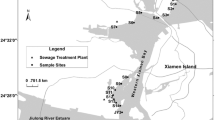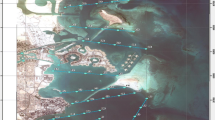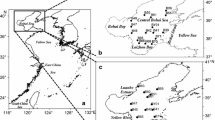Abstract
Metal concentrations were evaluated in water, bottom sediments, and biota in four field campaigns from 2002 to 2004 in the Potiguar Basin, northeastern Brazil, where offshore oil exploration occurs. Analyses were performed by inductively coupled plasma mass spectrometry and inductively coupled plasma optical emission spectrometry. Total metal concentrations in water (dissolved + particulate) and sediments were in the range expected for coastal and oceanic areas. Abnormally high concentrations in waters were only found for Ba (80 μg l−1) and Mn (12 μg l−1) at the releasing point of one of the outfalls, and for the other metals, concentrations in water were found in stations closer to shore, suggesting continental inputs. In bottom sediments, only Fe and Mn showed abnormal concentrations closer to the effluent releasing point. Metal spatial distribution in shelf sediments showed the influence of the silt–clay fraction distribution, with deeper stations at the edge of the continental shelf, which are much richer in silt–clay fraction showing higher concentrations than shallower sediments typically dominated by carbonates. Metal concentrations in estuarine (mollusks and crustaceans) and marine (fish) organisms showed highest concentrations in oysters (Crassostrea rhizophorae). Fish tissues metal concentrations were similar between the continental shelf influenced by the oil exploration area and a control site. The results were within the range of concentrations reported for pristine environments without metals contamination. The global results suggest small, if any, alteration in metal concentrations due to the oil exploration activity in the Potiguar Basin. For monitoring purposes, the continental inputs and the distribution of the clay–silt fraction need to be taken into consideration for interpreting environmental monitoring results.







Similar content being viewed by others
References
Aguiar, J. E., Marins, R. V., & Almeida, M. D. (2007). Comparação de metodologias de digestão de sedimentos marinhos para caracterização da geoquímica de metais-traço na plataforma continental nordeste oriental brasileira. Geochimica Brasiliensis, 21, 304–323.
Agusa, T., Kunito, T., Vasunaga, G., Iwata, H., Subramanian, A., Ismail, A., & Tanabe, S. (2004). Concentrations of trace elements in marine fish and its risk assessment in Malaysia. Marine Pollution Bulletin, 51, 896–911.
ANVISA, Agência Nacional de Vigilância Sanitária (1998). Portaria no 685 de 27 de Agosto de 1998. Available at: http://e-legis.anvisa.gov.br/leisref/public/showAct.php?id = 90&word = alimentos. Accessed 20 June 2010
Araujo, B. A., Almeida, M. G., Salomão, M. S. M. B., Gobo, R. R., Siqueira, V. C., Ovalle, A. R. C., & Rezende, C. E. (2010). Distribuição de Hg total e suas associações com diferentes suportes geoquímicos em sedimentos marinhos da margem continental brasileira: Bacia de Campos-Rio de Janeiro. Química Nova, 33, 501–507.
Arz, H. W., Patzold, G., & Wefer, G. (1999). Climatic changes during the last glaciation recorded in sediment cores from the northeastern Brazilian Continental Margin. Geo-Marine Letters, 19, 209–218.
Boutron, C. F. (1990). A clean laboratory for ultralow concentration heavy metal analysis. Fresenius’ Journal of Analytical Chemistry, 337, 482–491.
Brandsma, M. G., & Smith, J. P. (1996). Dispersion modeling perspectives on the environmental fate of produced water discharges. In M. Reed & M. Johnson (Eds.), Produced water 2: environmental issues and mitigation technology (pp. 215–224). New York: Plenum Press.
Campos, R. C., Resende, M. C. R., & Curtius, A. J. (1993). Application of the cold vapor technique to the speciation of mercury in fish samples after solvent extraction and methylmercury reduction directly in the organic medium. Journal Analytical Atomic Absorption Spectrometry, 8, 247–251.
Carvalho, C. E. V., Faria, V. V., Cavalcante, M. P. O., Gomes, M. P., & Rezende, C. E. (2000). Distribuição de metais pesados em peixes costeiros bentônicos da região de Macaé, Estado do Rio de Janeiro, Brasil. Ecotoxicology and Environmental Restoration, 3, 64–68.
Carvalho, C. E. V., Faria, V. V., Cavalcante, M. P. O., Gomes, M. P., & Rezende, C. E. (2001). Distribuição de metais pesados em mexilhões (Perna perna, L.) da Ilha de Santana, Macaé-Estado do Rio de Janeiro, Brasil. Ecotoxicology and Environmental Restoration, 4, 1–5.
Carvalho, C. E. V., Salomão, M. S. M. B., Molisani, M. M., Rezende, C. E., & Lacerda, L. D. (2002). Contribution of a medium-size tropical river to the particulate heavy-metal load for the South Atlantic Ocean. The Science of the Total Environment, 284, 85–93.
Carvalho, C. E., Gomes, M. P., & Lacerda, L. D. (1993). Heavy metal contamination of the marine biota along the Rio de Janeiro coast, SE-Brazil. Water, Air, and Soil Pollution, 57, 645–653.
Companhia de Tecnologia de Saneamento Ambiental. (1981). Estudo de mercúrio nas águas e estuário do Rio Botafogo—Pernambuco—1981. Fase I—Estudo preliminar (p. 39). São Paulo: CETESB.
CONAMA, Conselho Nacional do Meio Ambiente (2004). Resolução n. 344, de 25 de Março de 2004. Dredging Sediments Limits. Available in: http://www.mma.gov.br/port/conama/res/res04/res34404.xml Accessed on 03 September, 2011.
CONAMA, Conselho Nacional do Meio Ambiente (2005). Resolução n. 357, de 2005. Classificação dos corpos d’água. Available in: http://www.mma.gov.br/port/conama/res/res05/res35705.pdf Accessed on 03 September, 2011.
Crossland, C. J., Kremer, H. H., Lindeboom, H. J., Marshall-Crossland, J. I., & Le Tessier, M. D. A. (2005). Coastal fluxes in the Anthropocene (p. 231). Berlin: Springer.
de Mora, S., Fowler, S. W., Wyse, E., & Azemard, S. (2004). Distribution of heavy metals in marine bivalves, fish and costal sediments in the Persian Gulf and Gulf of Oman. Marine Pollution Bulletin, 49, 410–424.
Ekau, W., & Knoppers, B. A. (1999). Sedimentation processes and productivity in the continental shelf of east and northeast Brazil. Archives of Fisheries and Marine Research, 47, 109–140.
EPA. U.S. Environmental Protection Agency. (2000). Environmental assessment of final effluent limitations guidelines and standards for synthetic-based drilling fluids and other non-aqueous drilling fluids in the oil and gas extraction point source category. EPA 821-B-00-014 (p. 266). Washington: EPA Office of Water.
Francioni, E., Wagener, A. L. R., Calixto, R. C., & Bastos, G. C. (2004). Evaluation of Perna perna (Linné, 1758) as a tool to monitoring trace metals contamination in estuarine and coastal waters of Rio de Janeiro, Brazil. Journal of the Brazilian Chemical Society, 15, 103–110.
Freire, G. S. S., Lima, S., Maia, L. P., & Lacerda, L. D. (2004). Geochemistry of continental shelf sediments of the Ceará coast, NE Brazil. In Environmental geochemistry in tropical and subtropical environments (pp. 365–378). Berlin: Springer.
Gabardo, I. T., Platte, E. D., Lima, E. F. A., & Andrade, F. B. (2005). Caracterização do Efluente da Plataforma Curimã (PCR-1). In Relatório Técnico Parcial, RT AMA 024/2005 (p. 47). Rio de Janeiro: CENPES.
Gray, J. S., Bakke, T., Beck, H. J., & Nilssen, I. (1999). Managing the environmental effects of Norwegian oil and gas industry: from conflict to consensus. Marine Pollution Bulletin, 38, 525–530.
Haynes, D., & Johnson, J. E. (2000). Organochlorine, heavy metal and polyaromatic hydrocarbon pollutant concentrations in the Great Barrier Reef (Australia) environment: a review. Marine Pollution Bulletin, 41, 267–278.
Haynes, D., Leeder, J., & Rayment, P. (1997). A comparison of the bivalve species Donax deltoides and Mytilus edulis as monitors of metal exposure from effluent discharges along the Ninety Mile Beach, Victoria, Australia. Marine Pollution Bulletin, 34, 326–331.
Hübner, R., Astin, K. B., & Herbert, R. J. H. (2010). Dispersal and mobility of metal contamination across a salt marsh from coastal landfill sites using ammonium nitrate extractions as an indicator. Journal of Environmental Monitoring, 12, 740–747.
Johnsen, J., Utvik, T. I. R., Garland, E., De Vals, B., & Campbell, J. (2004). Environmental fate of contaminants in produced water. The Swedish SPE International Conference on Health, Safety and Environment in Oil and Gas Exploration and Production (p. 9). Calgary: Society of Petroleum Engineers. SPE 86708.
Juras, A. A. (1988). A preliminary survey of heavy metal concentrations in some estuarine organisms in the littoral zone of São Luis Island, Maranhão, Brazil. In U. Seeliger, L. D. Lacerda, & S. R. Patchineelam (Eds.), Metals in Coastal Environments of Latin America (pp. 16–20). Berlin: Springer Verlag.
Kennicutt, M. C., Boothe, P. N., Wade, T. L., Sweet, S. T., Rezak, R., Kelly, F. J., Brooks, J. M., Presley, B. J., & Wisenburg, D. A. (1996). Geochemical patterns in sediments near offshore production platforms. Canadian Journal of Aquatic Sciences, 53, 2540–2553.
Kennicutt, M. C., Green, R. H., Montagna, P. A., & Roscigno, P. F. (1996). Gulf of Mexico offshore operations monitoring experiment (GOOMEX). Phase I: sub-lethal responses to contaminant exposure—introduction and overview. Canadian Journal of Aquatic Sciences, 53, 2540–2553.
Knoppers, B. A., Ekau, W., & Figueiredo, A. G. (1999). The coast and shelf of east and northeast Brazil and material transport. Geo-Marine Letters, 19, 171–178.
Lacerda, L. D., & Molisani, M. M. (2006). Three decades of Cd and Zn contamination in Sepetiba bay, SE Brazil evidence from the mangrove oyster Crassostrea rhizophorae. Marine Pollution Bulletin, 52, 974–977.
Lacerda, L. D., & Marins, R. V. (2006). Geoquímica de sedimentos e o monitoramento de metais na plataforma continental Nordeste Oriental do Brasil. Geochimica Brasiliensis, 20, 123–135.
Lacerda, L. D., Rezende, C. E., Carvalho, C. E. V., Ovalle, A. R. C., & Pfeiffer, W. C. (1993). Mercury distribution in sediments of the Paraiba do Sul River Estuary, SE Brazil. Marine Pollution Bulletin, 20, 93–96.
Lacerda, L. D., Rezende, C. E., Ovalle, A. R., & Carvalho, C. E. (2004). Mercury distribution in continental shelf sediments from two offshore oil fields in southeastern Brazil. Bulletin of Environmental Contamination and Toxicology, 72, 178–185.
Lacerda, L. D., Santos, J. A., Campos, R. C., Gonçalves, R. A., & Salles, R. (2007). Total-Hg and organic-Hg in Cephalopholis fulva (Linnaeus, 1758) from inshore and offshore waters of NE Brazil. Brazilian Journal of Biology, 67, 493–498.
Loring, D. H., & Rantala, R. T. T. (1992). Manual for the geochemical analyses of marine sediments and suspended particulate matter. Earth-Science Reviews, 32, 235–283.
Marcovecchio, J. E. (2000). Overview on land-based sources and activities affecting the marine, coastal and associated freshwater environment in the Upper Southwest Atlantic Ocean. UNEP Regional Seas Reports and Studies No. 170, The Hague: UNEP/GPA. 78 p.
Marins, R. V., Lacerda, L. D., Paraquetti, H. H. M., Paiva, E. C., & Villas Boas, R. C. (1998). Geochemistry of mercury in sediments of a sub-tropical coastal lagoon, Sepetiba Bay, southeastern Brazil. Bulletin of Environmental Contamination and Toxicology, 61, 57–64.
Marins, R. V., Paula Filho, F. J., Lacerda, L. D., Rodrigues, S. R., & Marques, W. S. (2004). Distribuição de mercúrio total como indicador de poluição urbana e industrial na costa brasileira. Química Nova, 27, 763–770.
Martins, L. R., & Coutinho, P. N. (1981). The Brazilian continental margin. Earth Sciences Reviews, 17, 87–107.
Milliman, J. D., & Summerhayes, C. P. (1975). Upper continental margin sedimentation off Brazil. Contributions to Sedimentology, 4, 1–43.
Molisani, M. M., Salomão, M. S. M. B., Ovalle, A. R. C., Rezende, C. E., Lacerda, L. D., & Carvalho, C. E. V. (1999). Heavy metals in sediments of the lower Paraíba do Sul River and estuary, Southeastern Brazil. Bulletin of Environmental Contamination and Toxicology, 63, 682–690.
Muller, G. G., Irion, G., Morais, J. O. & Tintelnot, M. (1999). Heavy metal concentrations in fine grained sediments in the lower course of Brazilian rivers between the state of Piauí and Espírito Santo (p. 1–4). In: Abrão, J.J. (ed) Proceedings of the 3rd International Symposium on Environmental Geochemistry in Tropical Countries. Niterói: Universidade Federal Fluminense
Nascimento, F. S., Freire, G. S. S., & Miola, B. (2010). Geochemistry of marine sediments of the Brazilian Northeastern continental shelf. Brazilian Journal of Oceanography, 58, 1–11.
Neff, J. M. (2002). Bioaccumulation in marine organisms: effect of contaminants from oil well produced water (p. 452). Duxbury: Battelle Coastal Resources and Environmental Management.
Nriagu, J. O., Lawson, G., Wong, H. K. T., & Azcue, J. M. (1993). A protocol for minimizing contamination in the analysis of trace metals in Great Lakes waters. Journal of the Great Lakes Research, 19, 175–182.
OGP. (2005). Fate and effects of naturally occurring substances in produced water on the marine environment (p. 36). London: The International Association of Oil and Gas Producers. Report 364.
OOC [Offshore Operators Committee]. (1997). Gulf of Mexico produced water bioaccumulation study. Definitive component. In Technical report to the offshore operators committee (p. 30). New Orleans: Jupiter: Continental Shelf Associates.
Paranhos, R., & Ximenez, M. S. (2005). Programa de avaliação da qualidade da água e efluentes da Plataforma SS-06—Bacia de Campos—Bioincrustação e ictiofauna (p. 177). Rio de Janeiro: PETROBRAS/BIORIO/IB-UFRJ.
PETROBRAS [Petróleo Brasileiro S.A.]. (2004a). Relatório do Programa de Monitoramento Ambiental na Bacia de Campos no Campo de Roncador FPSO Brasil (p. 124). Rio de Janeiro: Centro de Pesquisas e Desenvolvimento Leopoldo Miguez de Mello, CENPES & Fundação COPPETEC-UFRJ.
PETROBRAS [Petróleo Brasileiro S.A.]. (2004b). Monitoramento da Plataforma Continental dos Estados de Sergipe e Alagoas sob Influência de Atividades Petrolíferas (p. 763). Maceió: PETROBRAS-Petróleo Brasileiro S/A & Universidade Federal de Sergipe.
PETROBRAS [Petróleo Brasileiro S.A.]. (2006). Relatório integrador do Programa de Monitoramento Ambiental da Bacia Potiguar (p. 126). Rio de Janeiro: Centro de Pesquisas e Desenvolvimento Leopoldo Miguez de Mello, CENPES.
Pozebon, D., Lima, E. C., Maia, S. M., & Fachel, J. M. G. (2005). Heavy metals contribution of non-aqueous fluids used in offshore oil drilling. Fuel, 84, 53–61.
Prego, R., & Cobelo-Garcia, A. (2003). Zinc concentration in the water column influenced by the oil spill in the vicinity of the Prestige shipwreck. Ciencias Marinas, 29, 103–108.
Prego, R., & Cobelo-Garcia, A. (2004). Cadmium, copper and lead contamination of the seawater column influenced by the oil spill on the Prestige shipwreck (NE Atlantic Ocean). Analytica Chimica Acta, 524, 23–26.
Ramos, R., Bastidas, C., & Garcia, E. (2012). Toxicity assays of marine sediments from western Venezuela. Ciencias Marinas, 38, 119–127.
Rezende, C. E., Lacerda, L. D., Ovalle, A. R. C., Souza, C. M. M., Gobo, A. A. R., & Santos, D. O. (2002). The effect of an oil drilling operation on the trace metal distribution in bottom sediments from the Brazilian continental platform. Marine Pollution Bulletin, 44, 680–684.
Rezende, C. E., Ovalle, A. R. C., Carvalho, C. E. V., & Lacerda, L. D. (2004). Geochemistry and spatial distribution from two offshore oil fields in Southeastern Brazil. In Environmental Geochemistry in Tropical and Subtropical Environments (pp. 355–364). Berlin: Springer.
Ruus, A., Tollefsen, K. E., Grung, M., Klungsoyr, J., & Hylland, K. (2006). Accumulation of contaminants in pelagic organisms, caged blue mussels, caged cod, and semipermeable membrane devices. In K. Hylland, T. Lang, & A. D. Vethaak (Eds.), Biological effects of contaminants in marine pelagic ecosystems (pp. 51–74). Brussels: SETAC Press.
Salomão, M. S. M. B., Molisani, M. M., Ovalle, A. R. C., Rezende, C. E., Lacerda, L. D., & Carvalho, C. E. V. (2001). Particulate heavy metal transport in the lower Paraíba do Sul River basin, southeastern Brazil. Hydrological Processes, 15, 587–593.
Salomons, W., & Forstner, U. (1984). Metals in the hydrocycle (p. 342). Berlin: Springer.
Silva, C. A. R., Rainbow, P. S., & Smith, B. D. (2003). Biomonitoring of trace metal contamination in mangrove-lined Brazilian coastal systems using oyster Crassostrea rhizophorae: comparative study of regions affected by oil, salt pond and shrimp farming activities. Hydrobiologia, 501, 199–206.
Silva, C. A. R., Rainbow, P. S., Smith, B. D., & Santos, Z. (2001). Biomonitoring of trace metal contamination in the Potengi estuary, Natal (Brazil), using the oyster Crassostraea rhizophorae, a local food source. Water Research, 35, 4072–4078.
Summerhayes, C. P., Coutinho, P. N., França, A. M. C., & Ellis, J. P. (1975). Salvador to Fortaleza, North-eastern Brazil. Contributions to Sedimentology, 4, 44–77.
Trefry, J. H., Naito, K. L., Trocine, R. P., & Metz, S. (1995). Distribution and bioaccumulation of heavy metals from polluted water discharges to the Gulf of Mexico. Water Science and Technology, 32, 31–36.
Trefry, J. H., Rember, R. D., Trocine, R. P., & Brown, J. S. (2003). Trace metals in sediments near offshore oil exploration and production sites in the Alaskan Arctic. Environmental Geology, 45, 149–160.
Utvik, T. I. R. (1999). Chemical characterization of produced water from four offshore oil production platforms in the North Sea. Chemosphere, 39, 2593–2606.
Vaisman, A. G., Marins, R. V., & Lacerda, L. D. (2005). Characterization of the mangrove oyster Crassostraea rhizophora, as a biomonitor for mercury in tropical estuarine systems. Bulletin of Environmental Contamination and Toxicology, 73, 582–588.
Windom, H. L., & Crammer, G. (1998). Lack of observed impacts of gás production of Bangkok Field, Thailand on marine biota. Marine Pollution Bulletin, 36, 799–804.
Acknowledgments
This work is part of the long-term monitoring program of Petroleo Brasileiro S.A. (PETROBRAS) of the offshore exploration areas at the Potiguar Basin. Thanks are also due to National Research Council of Brazil (CNPq; Proc. No. 573.601/2008-9) for providing grants and funding to the authors. The authors wish to thank PETROBRAS S.A. for allowing publication of part of the results and are particularly indebted to the crews of N/RB Astro Garoupa from PETROBRAS S.A. and from the NOc Professor Martins Filho, from the Federal University of Ceará, for the exhaustive logistic support during the monitoring program. The authors extend their thanks to two anonymous reviewers who kindly reviewed, detailed, and improved an earlier version of this manuscript.
Author information
Authors and Affiliations
Corresponding author
Rights and permissions
About this article
Cite this article
Lacerda, L.D., Campos, R.C. & Santelli, R.E. Metals in water, sediments, and biota of an offshore oil exploration area in the Potiguar Basin, Northeastern Brazil. Environ Monit Assess 185, 4427–4447 (2013). https://doi.org/10.1007/s10661-012-2881-9
Received:
Accepted:
Published:
Issue Date:
DOI: https://doi.org/10.1007/s10661-012-2881-9




